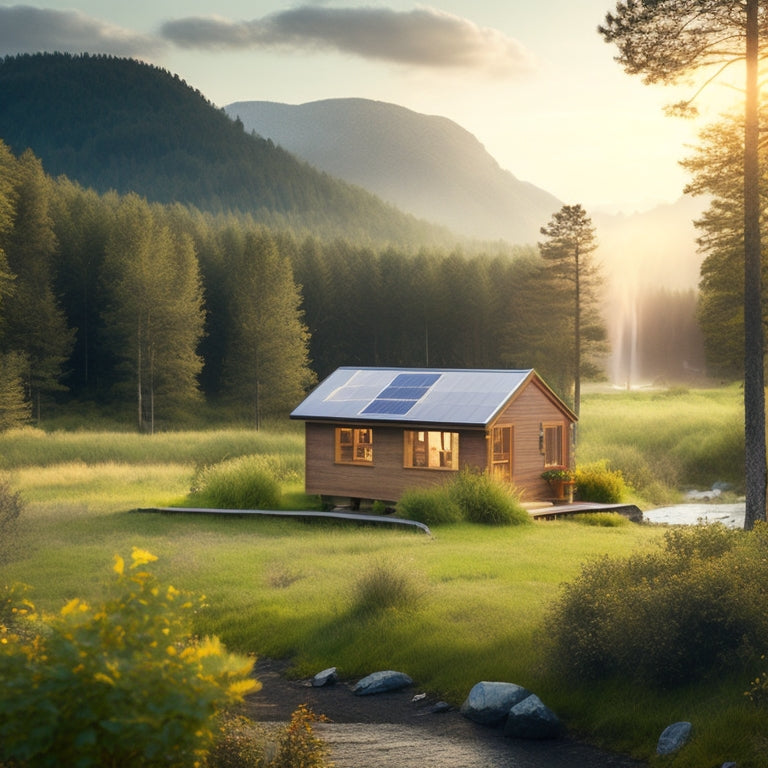
DIY Geothermal Power: Off-Grid Energy Independence Guide
Share
You're taking a proactive approach to achieving off-grid energy independence by exploiting the Earth's natural heat with a DIY geothermal power system. By circulating fluids through underground pipes, you can capture the Earth's heat and convert it into energy, reducing your reliance on traditional power sources. To get started, you'll need to assess your site, plan your system, and design a heat exchanger to make use of internal heat. You'll also need to choose the right piping materials and consider factors like energy demand and seasonal temperature variations. As you move forward, you'll uncover the specifics of building and maintaining a reliable DIY geothermal power system that meets your off-grid energy needs.
Key Takeaways
- Assess your site's geothermal potential by evaluating soil analysis, groundwater availability, and local regulations for off-grid energy independence.
- Choose a suitable heat exchanger type (plate, tube, or coil) based on your energy requirements and budget for efficient heat transfer.
- Design a reliable closed-loop or open-loop system, considering seasonal temperature variations and energy demand impacts, to ensure consistent performance.
- Select energy-efficient components with high coefficients of performance and durable piping materials (PEX, copper, or stainless steel) for long-term reliability.
- Monitor key performance metrics (energy output, temperature, flow rates) and perform routine inspections to ensure optimal system performance and prevent major issues.
Understanding Geothermal Energy Basics
You're probably familiar with traditional fossil fuels, but geothermal energy is a clean, renewable alternative that employs the Earth's natural heat.
This energy source captures heat transfer from the Earth's core to provide a sustainable and environmentally friendly power solution. Geothermal energy systems operate by circulating fluids through underground pipes, capturing heat, and converting it into electricity.
With a minimal environmental impact, geothermal energy offers a high system efficiency, resulting in significant energy savings. As you consider adopting geothermal energy, keep in mind that renewable energy solutions can reduce greenhouse gas emissions and support corporate sustainability goals.
Additionally, incorporating geothermal energy into your off-grid energy plan can contribute to a cleaner, more sustainable transportation sector.
Site Assessment and Planning
As you investigate the potential of geothermal energy, identifying a suitable site is paramount.
You'll need to evaluate site location, soil analysis, and environmental impact to guarantee a successful installation. Analyze resource availability, including groundwater and heat flow, to determine if geothermal energy is viable for your location.
Renewable energy sources like geothermal power harness Earth's internal heat for reliable electricity generation, making it an attractive option for off-grid energy independence.
Research local zoning regulations and budget considerations to avoid costly surprises. Seasonal variations in temperature and energy demand will also impact your system's design and performance.
Additionally, examine local incentives, such as tax credits or rebates, that can offset installation costs.
Building Your Geothermal System
The foundation of your DIY geothermal power system lies in the design and installation of a reliable heat exchanger, which efficiently employs the Earth's internal heat.
You'll need to choose from two primary system types: closed-loop or open-loop systems. Conduct a thorough cost analysis to determine which option suits your budget and energy needs.
As you design your system, consider the benefits of renewable energy solutions and how they can enhance your overall energy independence. Additionally, exploring alternative fuels like biodiesel and biofuels can further reduce your reliance on non-renewable sources.
Confirm your system is energy-efficient by selecting components with high coefficients of performance. Familiarize yourself with local regulatory considerations and environmental impact assessments to avoid potential roadblocks.
Be prepared to overcome installation challenges, such as drilling and piping, by following DIY tips and consulting with experts when necessary. Ascertain resource availability by sourcing materials from reputable suppliers.
Installing Heat Exchangers and Piping
With your DIY geothermal power system design in place, it's time to focus on the physical installation of heat exchangers and piping. You'll need to choose the right heat exchanger type and piping materials for your system. There are several heat exchanger types to evaluate, including plate, tube, and coil designs.
| Heat Exchanger Type | Advantages | Disadvantages |
|---|---|---|
| Plate | High efficiency, compact design | Higher cost, prone to fouling |
| Tube | Low cost, easy to clean | Lower efficiency, larger design |
| Coil | Flexible design, easy installation | Lower efficiency, prone to corrosion |
When selecting piping materials, assess durability, corrosion resistance, and thermal conductivity. Common piping materials include PEX, copper, and stainless steel. Remember to follow local building codes and regulations during installation.
Monitoring and Maintaining Performance
Beyond the initial installation, your DIY geothermal power system requires ongoing monitoring and maintenance to confirm peak performance and longevity.
You'll need to keep tabs on key performance metrics, such as energy output, temperature, and flow rates, to verify your system is running at ideal levels. Additionally, implementing grid-scale energy storage solutions can help stabilize the grid and reduce peak demand charges, further enhancing your system's performance.
Similarly, integrating advanced battery management systems can provide real-time monitoring of energy storage capacity, guaranteeing efficient performance.
To maintain your system's energy efficiency, make certain to:
- Perform routine inspections to identify potential issues before they become major problems
- Conduct regular cleaning and maintenance of heat exchangers and piping to prevent corrosion and scaling
- Implement system upgrades as needed to take advantage of new technologies and improve performance
- Analyze energy usage patterns to identify opportunities for improvement and enhance your system's configuration
Frequently Asked Questions
Can a Geothermal System Be Used for Cooling as Well as Heating?
You can utilize geothermal energy for both heating and cooling, leveraging the earth's consistent temperature to provide year-round climate control and energy efficiency, allowing you to slash your reliance on traditional HVAC systems.
How Long Does a Typical Geothermal System Last?
You'll find that a typical geothermal system can last up to 25 years or more with proper maintenance, which is essential for system longevity, and requires regular checks on the piping, pumps, and heat exchangers to guarantee peak performance.
Are Geothermal Systems Suitable for Small Homes or Apartments?
You'll be astonished to find that geothermal systems can be customized to fit even the tiniest of spaces, but you'll need to maneuver through geothermal sizing intricacies and installation challenges to achieve a seamless fit for your small home or apartment.
Can I Install a Geothermal System Myself Without Professional Help?
You can attempt to install a geothermal system yourself, but be prepared to face installation challenges, like drilling and piping, and consider the cost considerations, like equipment expenses, that may outweigh the benefits of DIY freedom.
Are There Any Government Incentives for DIY Geothermal Projects?
As you dig into DIY geothermal, a pot of gold awaits: government incentives! You'll unearth tax credits and grant programs that'll help offset system costs, giving you a green light to forge your own energy independence.
Related Posts
-

7 Best EV Battery Health Trackers for Homeowners
You can maximize your electric vehicle's performance and lifespan by leveraging advanced battery health trackers that...
-

7 Smart Air Purification Hacks for Energy-Savvy Homes
You can notably improve your indoor air quality while minimizing energy consumption by implementing strategic air pur...
-

Transform Your Outdoor Space With Recycled Plastic Lumber
By incorporating recycled plastic lumber into your outdoor design, you're not just building a deck or installing a fe...


